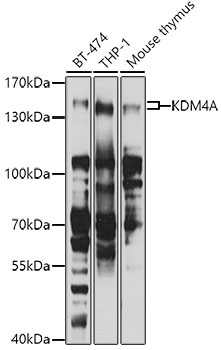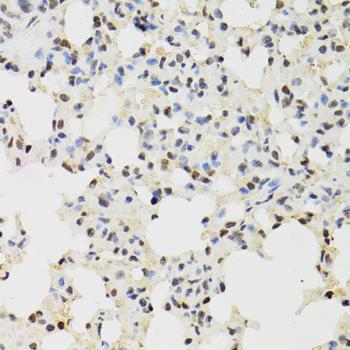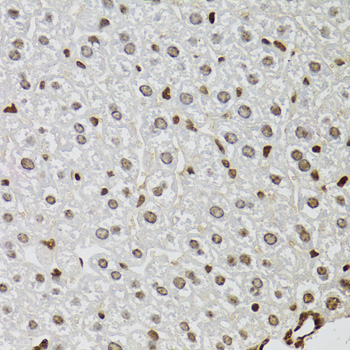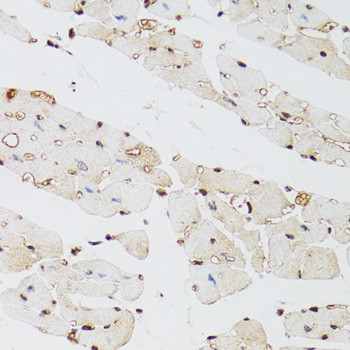-
Product Name
KDM4A Polyclonal Antibody
- Documents
-
Description
Polyclonal antibody to KDM4A
-
Tested applications
WB, IHC, IF, IP
-
Species reactivity
Human, Mouse
-
Alternative names
KDM4A antibody; JHDM3A antibody; JMJD2 antibody; JMJD2A antibody; TDRD14A antibody; lysine demethylase 4A antibody
-
Isotype
Rabbit IgG
-
Preparation
Antigen: Recombinant fusion protein containing a sequence corresponding to amino acids 585-815 of human KDM4A (NP_055478.2).
-
Clonality
Polyclonal
-
Formulation
PBS with 0.02% sodium azide, 50% glycerol, pH7.3.
-
Storage instructions
Store at -20℃. Avoid freeze / thaw cycles.
-
Applications
WB 1:500 - 1:2000
IHC 1:50 - 1:200
IF 1:50 - 1:100
IP 1:50 - 1:100 -
Validations

Western blot - KDM4A Polyclonal Antibody
Western blot analysis of extracts of various cell lines, using KDM4A antibody at 1:1000 dilution.Secondary antibody: HRP Goat Anti-Rabbit IgG (H+L) at 1:10000 dilution.Lysates/proteins: 25ug per lane.Blocking buffer: 3% nonfat dry milk in TBST.Detection: ECL Basic Kit .Exposure time: 90s.

Immunohistochemistry - KDM4A Polyclonal Antibody
Immunohistochemistry of paraffin-embedded mouse lung using KDM4A antibody at dilution of 1:100 (40x lens).

Immunohistochemistry - KDM4A Polyclonal Antibody
Immunohistochemistry of paraffin-embedded mouse liver using KDM4A antibody at dilution of 1:100 (40x lens).

Immunohistochemistry - KDM4A Polyclonal Antibody
Immunohistochemistry of paraffin-embedded mouse heart using KDM4A antibody at dilution of 1:100 (40x lens).
-
Background
Histone demethylase that specifically demethylates 'Lys-9' and 'Lys-36' residues of histone H3, thereby playing a central role in histone code. Does not demethylate histone H3 'Lys-4', H3 'Lys-27' nor H4 'Lys-20'. Demethylates trimethylated H3 'Lys-9' and H3 'Lys-36' residue, while it has no activity on mono- and dimethylated residues. Demethylation of Lys residue generates formaldehyde and succinate. Participates in transcriptional repression of ASCL2 and E2F-responsive promoters via the recruitment of histone deacetylases and NCOR1, respectively.; Isoform 2: Crucial for muscle differentiation, promotes transcriptional activation of the Myog gene by directing the removal of repressive chromatin marks at its promoter. Lacks the N-terminal demethylase domain.
Related Products / Services
Please note: All products are "FOR RESEARCH USE ONLY AND ARE NOT INTENDED FOR DIAGNOSTIC OR THERAPEUTIC USE"
